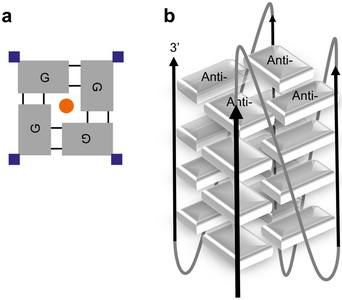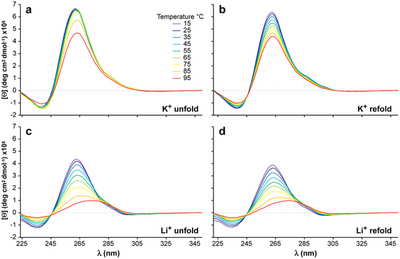Fratta, P;
Mizielinska, S;
Nicoll, AJ;
Zloh, M;
Fisher, EM;
Parkinson, G;
Isaacs, AM;
(2012)
C9orf72 hexanucleotide repeat associated with amyotrophic lateral sclerosis and frontotemporal dementia forms RNA G-quadruplexes.
Scientific Reports
, 2
, Article 1016. 10.1038/srep01016.

Preview |
PDF
srep01016.pdf Download (597kB) |
![[thumbnail of JPG Figure 1: Schematic representation of the parallel stranded GGGGCC RNA G-quadruplex.]](https://discovery.ucl.ac.uk/1381390/2.hassmallThumbnailVersion/srep01016-f1.jpg)  Preview |
Other (JPG Figure 1: Schematic representation of the parallel stranded GGGGCC RNA G-quadruplex.)
srep01016-f1.jpg Download (192kB) |
![[thumbnail of JPG Figure 2: The C9orf72 hexanucleotide repeat is predicted to form a G-quadruplex structure.]](https://discovery.ucl.ac.uk/1381390/3.hassmallThumbnailVersion/srep01016-f2.jpg)  Preview |
Other (JPG Figure 2: The C9orf72 hexanucleotide repeat is predicted to form a G-quadruplex structure.)
srep01016-f2.jpg Download (74kB) |
![[thumbnail of JPG Figure 3: NMR analysis of the C9orf72 GGGGCC RNA hexanucleotide repeat shows formation of G-quadruplexes.]](https://discovery.ucl.ac.uk/1381390/4.hassmallThumbnailVersion/srep01016-f3.jpg)  Preview |
Other (JPG Figure 3: NMR analysis of the C9orf72 GGGGCC RNA hexanucleotide repeat shows formation of G-quadruplexes.)
srep01016-f3.jpg Download (59kB) |
![[thumbnail of JPG Figure 4: CD analysis shows the GGGGCC RNA G-quadruplex structures are very stable, cation dependent and parallel oriented.]](https://discovery.ucl.ac.uk/1381390/5.hassmallThumbnailVersion/srep01016-f4.jpg)  Preview |
Other (JPG Figure 4: CD analysis shows the GGGGCC RNA G-quadruplex structures are very stable, cation dependent and parallel oriented.)
srep01016-f4.jpg Download (129kB) |
Preview |
PDF (Supplementary Information)
srep01016-s1.pdf Download (529kB) |
Abstract
Large expansions of a non-coding GGGGCC-repeat in the first intron of the C9orf72 gene are a common cause of both amyotrophic lateral sclerosis (ALS) and frontotemporal dementia (FTD). G-rich sequences have a propensity for forming highly stable quadruplex structures in both RNA and DNA termed G-quadruplexes. G-quadruplexes have been shown to be involved in a range of processes including telomere stability and RNA transcription, splicing, translation and transport. Here we show using NMR and CD spectroscopy that the C9orf72 hexanucleotide expansion can form a stable G-quadruplex, which has profound implications for disease mechanism in ALS and FTD.
Archive Staff Only
 |
View Item |


